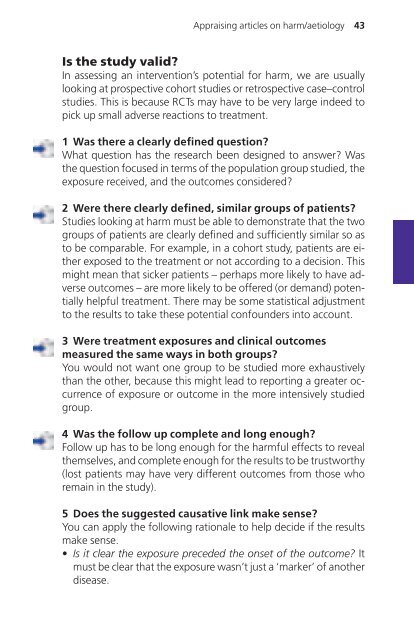Evidence-based Medicine Toolkit
Evidence-based Medicine Toolkit
Evidence-based Medicine Toolkit
You also want an ePaper? Increase the reach of your titles
YUMPU automatically turns print PDFs into web optimized ePapers that Google loves.
Appraising articles on harm/aetiology 43Is the study valid?In assessing an intervention’s potential for harm, we are usuallylooking at prospective cohort studies or retrospective case–controlstudies. This is because RCTs may have to be very large indeed topick up small adverse reactions to treatment.1 Was there a clearly defined question?What question has the research been designed to answer? Wasthe question focused in terms of the population group studied, theexposure received, and the outcomes considered?2 Were there clearly defined, similar groups of patients?Studies looking at harm must be able to demonstrate that the twogroups of patients are clearly defined and sufficiently similar so asto be comparable. For example, in a cohort study, patients are eitherexposed to the treatment or not according to a decision. Thismight mean that sicker patients – perhaps more likely to have adverseoutcomes – are more likely to be offered (or demand) potentiallyhelpful treatment. There may be some statistical adjustmentto the results to take these potential confounders into account.3 Were treatment exposures and clinical outcomesmeasured the same ways in both groups?You would not want one group to be studied more exhaustivelythan the other, because this might lead to reporting a greater occurrenceof exposure or outcome in the more intensively studiedgroup.4 Was the follow up complete and long enough?Follow up has to be long enough for the harmful effects to revealthemselves, and complete enough for the results to be trustworthy(lost patients may have very different outcomes from those whoremain in the study).5 Does the suggested causative link make sense?You can apply the following rationale to help decide if the resultsmake sense.• Is it clear the exposure preceded the onset of the outcome? Itmust be clear that the exposure wasn’t just a ‘marker’ of anotherdisease.










